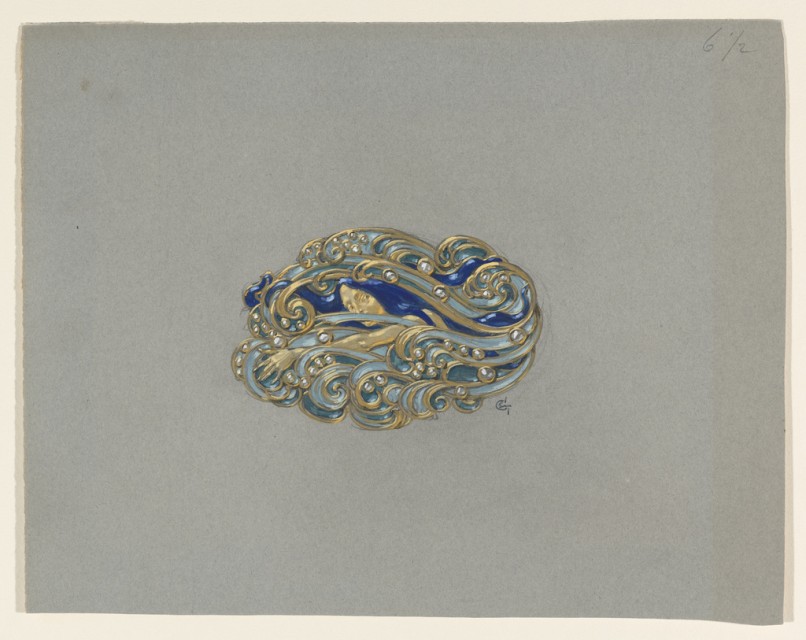Graceful, swirling arcs envelop a golden-skinned, blue-coiffed woman. Her eyes flicker back while her arm reaches forward, as if she is swimming away into the gilt turquoise surf intertwined with her cobalt locks. Is she swimming amongst peaceful waves or against a looming kelp forest of her own serpentine locks?
This Design for a Nymph Brooch by Eugène-Samuel Grasset was conceived around 1900 as a part of a collaboration with renowned Parisian jewelers Henri and Paul Vever. The finished brooch, realized in gold, enamel, and pearls, was exhibited at the Universal Exposition of 1900. At the time, Grasset was nearly 60 years of age and was long-established as a designer of posters, illustrations, book-bindings, fabrics, and furniture. Along with his jewelry, Grasset’s tapestries, stained glass, and chromo-lithographs were also on display at the Exposition.
An active art teacher and theorist, Grasset once mused that his art was “the opulence of shape added to the purely useful aspects of objects.”[1] Born in 1841 in Lausanne, Switzerland, Grasset originally trained as an architect before moving on to illustrations and design. His gradually codified style, the result of a lengthy and varied career, can be seen in its mature state in Design for a Nymph Brooch.
In true Art Nouveau fashion, Grasset’s brooch reflects a range artist movements, trends, and influences that came to a head at the turn of the twentieth century. The sweeping curves of the brooch’s pearl-tipped waves suggest the vegetal ornamentation of Japanese Art, while the bright blue hues-achieved with painted enamel during the production stage, illustrate a fin-de-siècle trend of moving away from strict reliance on precious stones and metals in fine jewelry. Echoes of the Gothic Revival style and its champion, Viollet-le-Duc, manifest themselves in the mysterious maiden. Delicate, ethereal, and enigmatic, she embodies the Art Nouveau paradigm. The prevalence and supremacy of female subjects in Art Nouveau reflect both the Symbolist movement –which emphasized the gothic, mythic and otherworldly, and signify the complex and unsteady role occupied by women at the turn of the century. At once creatures relegated to the domestic sphere and prized for their physical appearance and subservience to men, women were also experiencing the changing sociological tides that came with a burgeoning middle class and an emboldened advertising industry. The result was an idealized, exaggerated creature, more fantastic than real.
[1] Arwas, Victor. Berthon & Grasset. (New York: Rizzoli International Publications, Inc., 1978): 54.
